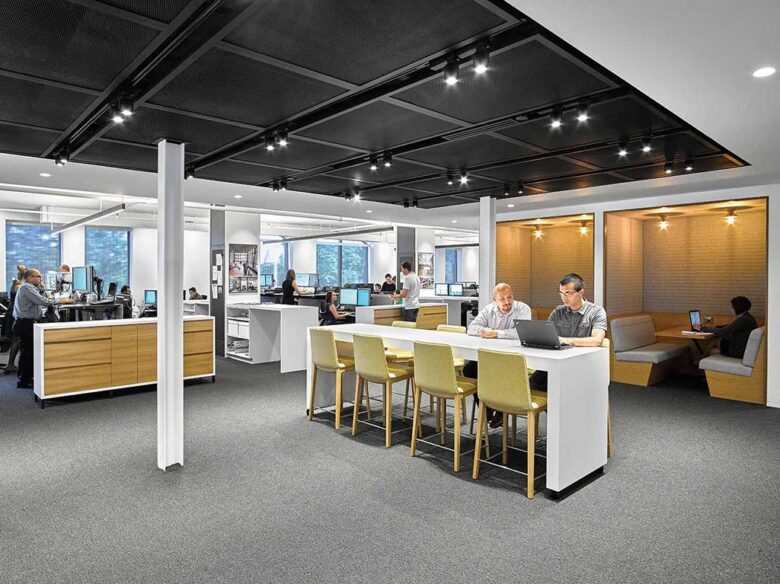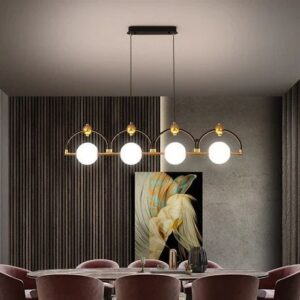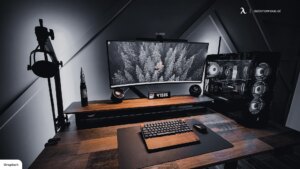Customizing and proper lighting can maximize productivity in the workplace. A well-designed workspace lets individuals maximize performance while avoiding distractions. Personalizing their surrounding can help employees create an environment that boosts focus and creativity.
Layout is a key part of customization. Arranging furniture and equipment for efficiency and accessibility is important. Putting commonly used items within arm’s reach saves time and helps prevent interruptions. Ergonomic furniture also ensures employees are comfortable.
Lighting is essential for an optimal work environment. Natural light increases alertness, improves mood and boosts productivity. Placing workstations near windows or investing in skylights can be useful. Artificial lighting can be used in areas with limited natural light. Bright yet soft lighting prevents eye strain and fatigue.
Personalizing workspaces with meaningful decorations can further enhance productivity. Plants, artwork, or personal mementos can inspire creativity and reduce stress. Items that evoke positive emotions can foster a more productive mindset.
Introducing adjustable ambient lighting options is another suggestion. Allowing employees to control brightness and color temperature enables them to customize the workspace according to their needs throughout the day. Warm light tones promote relaxation, while cooler tones stimulate focus and concentration.
The Importance of Workspace Customization and Lighting
Workspace customization and lighting are vital for maximizing productivity. Customizing your workspace boosts focus, motivation, and creativity. Adjustable desks, ergonomic chairs, and organized storage systems can help you work more efficiently. Good lighting also helps your mood and prevents eye strain. These details create a productive work environment.
Pro Tip: Natural light is great for increasing energy levels and productivity. Incorporate it whenever you can!
Step 1: Assessing Your Workspace
Assessing Your Workspace: A Professional Approach
To maximize productivity, it is crucial to assess your workspace. Here’s a concise guide to help you:
- Evaluate the layout: Analyze how your workspace is organized, ensuring it promotes efficiency and comfort. Consider the arrangement of furniture, equipment, and supplies.
- Examine lighting conditions: Assess the lighting in your workspace. Natural light is ideal, but if not available, ensure artificial lighting is sufficient and not too harsh or dim. Consider using adjustable desk lamps or overhead lights.
- Check ergonomics: Assess the ergonomic aspects of your workspace, such as chair height, desk height, and computer monitor position. Make necessary adjustments to ensure optimal comfort and reduce the risk of fatigue or strain.
Additionally, keeping your workspace clean and clutter-free can contribute to a more focused and organized environment.
A Story to Reflect Upon:
A colleague of mine, Mark, was struggling to stay productive in his workspace. He decided to assess it thoroughly, making noticeable changes. He rearranged his desk, creating a more ergonomic setup, and invested in a desk lamp for customized lighting. As a result, Mark experienced a significant boost in productivity and found himself more motivated to tackle tasks throughout the day. This simple act of workspace customization made a remarkable difference in his work performance.
By assessing your workspace, you can identify areas for improvement and optimize your productivity. Implementing small changes tailored to your needs can lead to substantial enhancements in your work environment.
“Finding the perfect desk and chair is like dating, sometimes you have to go through a lot of bad matches before you find ‘the one’ that doesn’t leave you with back pain.”
Evaluating Your Desk and Chair
Let’s take a look at the key elements of desks and chairs to create a well-functioning workspace!
Desk:
- Height: adjustable
- Surface Area: spacious
- Ergonomics: supportive
- Material: sturdy
- Storage Options: ample
Chair:
- Height: adjustable
- Surface Area: sufficient
- Ergonomics: comfortable
- Material: durable
- Storage Options: convenient
Remember, your desk must have enough room for all your stuff. And the chair should give you enough support to keep your posture proper.
Surprise! A study by the Journal of Human Ergology shows that an ergonomic workspace can boost productivity and reduce discomfort if you spend lots of time at the desk.
Organizing and Decluttering Your Workspace
Organizing and decluttering your workspace is essential for productivity. Streamline your surroundings for a more focused environment. Here are some key points:
- Clear unnecessary items. Get rid of old documents and unused supplies.
- Create storage areas. Assign places for different items so you can find them quickly.
- Arrange items based on frequency of use. Keep frequently used items close, and less-used ones away.
- Minimize distractions. Keep your workspace free from clutter, decorations, and gadgets that may take your attention.
- Implement a filing system. Categorize documents and papers into folders, preventing them from piling up on your desk.
- Maintain cleanliness. Clean and tidy your workspace regularly for a fresh atmosphere that boosts productivity.
Organizing and decluttering is an ongoing process. Reassess your workspace and adapt it to your needs. Personalization is also important. Add touches of personality to make the space comfortable and creative, but don’t add too much.
An author experienced the importance of organized workspace. Her creativity was hindered by a messy desk. She decluttered her workspace until it was immaculate. This small change resulted in an increase in productivity and creative breakthroughs.
Step 2: Choosing the Right Lighting
Choosing the appropriate lighting is crucial when it comes to maximizing productivity in your workspace. The right lighting can enhance your focus, reduce eye strain, and create a more comfortable environment. Here is a step-by-step guide to help you choose the perfect lighting for your workspace:
- Assess your lighting needs: Begin by evaluating the natural light available in your workspace. Determine if you need additional lighting or if you can rely on natural light sources.
- Understand different lighting options: Familiarize yourself with the various lighting options available, such as overhead lighting, task lighting, and ambient lighting. Each type serves a different purpose and can be used in combination for optimal results.
- Consider color temperature: Pay attention to the color temperature of the lighting. Warm lighting (lower color temperature) is more relaxing, while cool lighting (higher color temperature) promotes alertness and concentration. Choose a color temperature that aligns with your work requirements.
- Opt for adjustable lighting: Select lighting fixtures that allow you to adjust the brightness and intensity. This flexibility enables you to adapt the lighting to different tasks or moods throughout the day.
- Prioritize energy efficiency: Choose energy-efficient lighting options, such as LED bulbs, to reduce your environmental impact and save on electricity costs. LEDs also offer long-lasting performance and emit less heat, making them safer for prolonged use.
- Test and adjust: Once you have installed your chosen lighting setup, test it out and make any necessary adjustments. Pay attention to how the lighting affects your productivity, mood, and overall comfort. Don’t hesitate to fine-tune the lighting until you find the perfect balance.
In addition to these steps, it’s worth noting that proper lighting can also contribute to a positive work environment and boost your overall well-being. By investing time in choosing the right lighting, you can create a workspace that promotes productivity and enhances your work experience.
True Story:
A freelancer, Sarah, struggled with low productivity until she discovered the impact of lighting on her focus. After researching different lighting options, she invested in a task lamp with adjustable brightness. The improved lighting conditions significantly increased her concentration, allowing her to complete projects more efficiently. Sarah now swears by the importance of choosing the right lighting for a productive workspace.
Lighting plays a crucial role in productivity – just ask anyone who’s fallen asleep under flickering fluorescents.
Understanding the Impact of Lighting on Productivity
Lighting is essential for productivity. It can help or hinder how we feel and how we do our work. Good lighting can create a positive atmosphere, leading to focus, alertness, and motivation. Bad lighting leads to fatigue, eyestrain, and less productivity.
For understanding the effect of lighting on productivity, both natural and artificial lights must be taken into consideration. Natural light has been found to raise moods and energy, so having windows or skylights in the office can be beneficial.
Additionally, bright white lights are good for places where concentration is needed. They simulate daylight and give an energizing feeling. For more tranquil activities, softer yellow or amber lights can create a comfortable atmosphere.
Positioning and intensity of the lights matters too. Positioning the lights correctly can avoid glare on computer screens, reducing eye strain. Dimmer switches and adjustable lamps provide control over the environment, plus the ability to customize based on personal preferences.
By considering these points when picking lighting, you can make a space that works for productivity and well-being. So, get your lights right!
Types of Lighting for Different Tasks
Light has great importance for setting the right atmosphere and boosting productivity. Knowing the types of lighting for different tasks helps make good decisions. Here they are:
Task Lighting: Gives targeted light for activities like reading, writing, or cooking. It ensures visibility and reduces eye strain. Desk lamps, under-cabinet lights, and pendant lights are examples.
Ambient Lighting: Gives a welcoming feeling by spreading light around the room. It gets rid of shadows and gives general lighting. Chandeliers, ceiling-mounted fixtures, and wall sconces are examples.
Accent Lighting: Adds depth by emphasizing features, art, or decorations. It makes things look interesting and draws attention to particular objects or spots. Track lights, spotlights, and picture lights are accent lighting.
Natural Lighting: Uses sunlight to light up a space. It creates a bright and refreshing atmosphere while saving energy. Windows, skylights, and glass doors can be used to get the most natural lighting.
Pro Tip: A combination of these types of lighting can increase the functionality and beauty of any area. Try different mixes to get the desired effect while taking into account factors like color temperature, brightness, and placement.
Step 3: Optimizing Your Workspace Setup
Maximizing Productivity with Workspace Customization and Lighting is an article that provides valuable insights on how to optimize your workspace setup.
To optimize your workspace setup, follow these five steps:
- Arrange the furniture: Place your desk in a way that maximizes natural light and minimizes glare on your computer screen.
- Organize your tools: Keep frequently used items within arm’s reach and ensure a clutter-free workspace to promote focus and efficiency.
- Customize your ergonomics: Adjust your chair, monitor, and keyboard to promote proper posture and reduce the risk of physical discomfort or fatigue.
- Enhance lighting conditions: Use a combination of natural and artificial light sources to create a well-lit workspace that suits your needs and minimizes eye strain.
- Personalize your space: Add elements that inspire and motivate you, such as plants, artwork, or personal items, to create a positive and uplifting environment.
In addition to these steps, it is important to consider the specific needs and preferences of your work style. Experiment with different setups to find the one that enhances your productivity the most.
A study conducted by the Journal of Environmental Psychology found that personalized workspaces can increase job satisfaction and overall well-being of employees.
Get your desk in order and your productivity will follow suit, because chaos may be a ladder, but it’s also a major distraction.
Arranging Your Desk and Equipment
A productive workspace needs to be organized. Here’s some tips for setting up your desk and equipment:
- Position your computer monitor so it’s in front of you, at eye level. This’ll reduce strain on your neck and eyes.
- Put frequently used items like phones and notebooks near your desk, so you can get to them easily.
- Manage your cables with cable management solutions to keep them untangled and hidden.
- Use drawers and shelves to store stuff and keep your desk clear.
- Personalize your workspace with plants or decorations that motivate you.
Natural lighting is great for mood and productivity too, so try not to rely on fluorescent lights.
Did you know? A study by the Journal of Environmental Psychology showed that employees who could control their workspace arrangement were more productive and happier than those who couldn’t.
Incorporating Ergonomic Features
Incorporating Ergonomic Features
For optimal comfort and productivity, ergonomic features play a major role in setting up your workspace. Let’s dive into the most important elements to consider:
Table Design
- Get an adjustable-height desk that lets you switch between sitting and standing.
- Make sure it has enough space for all work items.
- Round or curved edges can avoid tension on your wrists.
Chair Selection
- Choose one with adjustable height and lumbar support.
- Armrests should give proper support and alignment for your arms.
Monitor Placement
- Place the monitor at eye-level, 20 inches away from your face.
- Use a monitor stand if needed to get the ideal viewing height.
Keyboard and Mouse
- Use an ergonomic keyboard and mouse that promote a natural hand position.
- Wrist rests can also provide extra support while typing or using the mouse.
Lighting
- Illuminate your workspace with natural or artificial light.
- Keep your computer screen away from direct light sources to avoid glare.
Additionally, don’t forget to take short breaks every hour to relax and stretch your muscles. Incorporating ergonomics in your setup can reduce the risk of musculoskeletal disorders and boost productivity.
Pro Tip: Regularly check and adjust the workspace based on changes and feedback. Comfort should always be the priority when making an ergonomic workspace.
Step 4: Personalizing Your Workspace
Personalize Your Workspace for Maximum Productivity
Creating a workspace that is tailored to your preferences and needs can greatly enhance your productivity. Here is a 5-step guide to personalizing your workspace:
- Organize your tools: Arrange your essential tools, such as pens, notebooks, and computer accessories, in an easily accessible and visually pleasing manner.
- Add personal touches: Incorporate items that inspire you, such as motivational quotes, photographs, or artwork, to create a positive and engaging atmosphere.
- Customize lighting: Adjust the lighting in your workspace to suit your needs. Consider using natural light sources or adjustable artificial lights to create a well-lit and comfortable environment.
- Optimize ergonomics: Set up your workspace to promote good posture and reduce strain on your body. Ensure your chair, desk, and computer are adjusted to the correct height and position to prevent discomfort.
- Minimize distractions: Remove any unnecessary items or distractions from your workspace. Keep only the essentials within reach to maintain focus and avoid clutter.
To further enhance your workspace, consider investing in ergonomic furniture or accessories that promote comfort and productivity. By personalizing your workspace, you can create an environment that is conducive to your work style and maximize your efficiency.
In addition to these tips, it’s important to find what works best for you individually. Experiment with different customization options to discover what helps you stay focused and motivated throughout the day.
True Story: A friend of mine, who struggled with productivity at work, decided to personalize her workspace by adding plants and calming scents. She found that the presence of greenery and soothing fragrances improved her concentration and overall mood, leading to increased productivity. This simple customization made a significant difference in her ability to focus and accomplish tasks efficiently.
Who needs motivational posters when you can decorate your workspace with a disco ball, reminding you that productivity is just a few dance moves away?
Adding Decorative Elements
Adding decorative elements to your workspace is a must for personalizing it. It enhances the look and brings a feeling of comfort and motivation. Here’s a four-step guide to help you.
| Step | Description |
|---|---|
| 1 | Choose a color scheme. Pick colors that match your personality and create a positive atmosphere. Blues & greens give a serene feel, while yellows and oranges add energy. |
| 2 | Get meaningful artwork. Hang pieces that reflect your interests or values. Abstract paintings, motivational quotes and photos of loved ones can help boost creativity & motivation. |
| 3 | Add plants. Indoor plants bring life and improve air quality. Succulents & snake plants are easy to care for. Put them in stylish pots or planters. |
| 4 | Personalize with accessories. Desk organizers, trays, holders, and lighting fixtures match your style & enhance functionality. |
Personalization is key. Try different arrangements until you find what inspires you & makes you feel comfortable. Create an environment that reflects who you are – productivity and work experience will be elevated! So, start transforming your workspace today!
Including Plants for a Calming Environment
Forget about boring workspaces! Adding nature to your office can really make a difference. Plants can not only spruce up the place, but offer lots of benefits. They can:
- Improve air quality – plants absorb toxins and release oxygen.
- Reduce stress – being surrounded by greenery helps keep you calm.
- Boost productivity – plants can help increase creativity and job satisfaction.
- Provide natural noise reduction – plants can absorb sound waves.
When picking plants, choose low-maintenance varieties that do well indoors. Take into account lighting, temperature, and humidity levels in your office. Some favorites include Snake Plant, Pothos, Spider Plant, and Peace Lily.
Nature has been a part of workplaces for ages. People have always known how plants can improve wellbeing. For example, “Shinrin-Yoku” or forest bathing, is a Japanese practice of immersing oneself in trees for stress relief.
Invite nature into your workspace and enjoy the benefits!
Conclusion
It is clear that workspace customization and lighting are important for productivity. Let’s recap:
- Ergonomic layouts are essential.
- Lighting can help focus and reduce eye strain.
- Personalization of the workspace boosts motivation.
Plus, adding natural elements like plants or natural light can be beneficial.
Pro Tip: Use adjustable lighting for the best focus and energy levels.
Additional Tips and Resources for Maximizing Productivity with Workspace Customization and Lighting
Creating a workspace with optimal lighting is key for productivity. Everyone’s preferences differ, so experiment until you find what’s best for you. There are also extra tips to consider.
For example, investing in ergonomic furniture, such as adjustable chairs and desks, to support good posture. Add personal touches, like photos and motivational quotes, to make the space reflective of you. Plus, keep it organized with storage solutions.
Lighting is also key. Incorporate natural light from windows and artificial sources. Consider the colors too – certain hues can have a positive effect on mood. Take steps to reduce noise – sound-absorbing materials or noise-canceling headphones.
Finally, think about plants. They add a touch of nature, improve air quality, reduce stress, and boost creativity. Transform your workspace into a productive oasis with a few indoor plants.
The concept of workspace customization and lighting goes back centuries. Ancient Greeks designed well-lit libraries, and Renaissance artists sought optimal lighting in their studios. Nowadays, with technology and knowledge, we’re able to create workspaces that maximize productivity.
Frequently Asked Questions
1. How can workspace customization maximize productivity?
Workspace customization allows you to tailor your working environment to your specific needs, which can enhance productivity. By organizing your space, removing distractions, and incorporating ergonomic elements, you can create an environment that promotes focus and efficiency.
2. What are some effective workspace customization strategies?
– Declutter your workspace regularly
– Use organizers and storage solutions for better organization
– Personalize your workspace with motivational elements
– Incorporate ergonomic furniture and accessories
– Arrange your work tools and equipment for easy access
3. How does lighting affect productivity?
Lighting plays a crucial role in productivity as it affects mood, focus, and overall well-being. Insufficient lighting can strain the eyes and lead to fatigue, while excessive lighting can cause glare and headaches. Optimal lighting, such as natural light or adjustable artificial lighting, can promote alertness and enhance productivity.
4. What are some tips for optimizing lighting in the workspace?
– Utilize natural light by positioning your desk near windows
– Choose adjustable lighting fixtures to control brightness
– Use task lighting for specific work areas and reduce overall glare
– Consider using full-spectrum lighting for a more natural ambiance
5. How can color choice impact productivity in workspace customization?
Color has a psychological impact on our mood and productivity. Cool colors like blue and green can promote concentration, while warmer colors like yellow and orange can stimulate creativity. It’s important to choose colors that align with your work objectives and create a conducive atmosphere.
6. Are standing desks beneficial for productivity?
Standing desks have gained popularity due to their potential benefits for productivity. They allow for better posture, increased movement, and can alleviate some of the health risks associated with prolonged sitting. However, the effectiveness of standing desks varies from person to person, so it’s important to find what works best for you.



